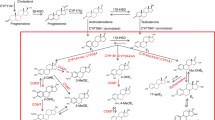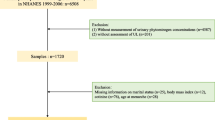Abstract
Phytoestrogens are plant-derived compounds that may interact with estrogen receptors and mimic estrogenic effects. It remains unclear whether the individual variability in metabolizing phytoestrogens contributes to phytoestrogens-induced beneficial or detrimental effects. Our aim was to determine whether there is any interaction between metabolic rates (MR) of phytoestrogens and genetic polymorphisms in related xenobiotic metabolizing enzyme genes. MR was used to assess phytoestrogen exposure and individual metabolic ability. The amount of phytoestrogens in urine was measured by ultra-high performance liquid chromatography-tandem mass spectrometry in 600 idiopathic infertile male patients and 401 controls. Polymorphisms were genotyped using the SNPstream platform combined with the Taqman method. Prototypes and metabolites of secoisolariciresinol (SEC) have inverse effects on male reproduction. It was found that low MR of SEC increased the risk of male infertility (OR 2.49, 95 % CI 1.78, 3.48, P trend = 8.00 × 10−8). Novel interactions were also observed between the MR of SEC and rs1042389 in CYP2B6, rs1048943 in CYP1A1, and rs1799931 in NAT2 on male infertility (P inter = 1.06 × 10−4, 1.14 × 10−3, 3.55 × 10−3, respectively). By analyzing the relationships between urinary phytoestrogen concentrations, their metabolites and male infertility, we found that individual variability in metabolizing SEC contributed to the interpersonal differences in SEC’s effects on male reproduction.


Similar content being viewed by others
References
Adjakly M, Bosviel R, Rabiau N et al (2011) DNA methylation and soy phytoestrogens: quantitative study in DU-145 and PC-3 human prostate cancer cell lines. Epigenomics 3:795–803
Atkinson C, Berman S, Humbert O et al (2004) In vitro incubation of human feces with daidzein and antibiotics suggests interindividual differences in the bacteria responsible for equol production. J Nutr 13:596–599
Atkinson C, Frankenfeld CL, Lampe JW (2005) Gut bacterial metabolism of the soy isoflavone daidzein: exploring the relevance to human health. Exp Biol Med 230:155–170
Barry KH, Koutros S, Berndt SI et al (2011) Genetic variation in base excision repair pathway genes, phytoestrogensticide exposure, and prostate cancer risk. Environ Health Perspect 119:1726–1732
Bolca S, Possemiers S, Herregat A et al (2007) Microbial and dietary factors are associated with the equol producer phenotype in healthy postmenopausal women. J Nutr 137:2242–2246
Cederroth CR, Nef S (2009) Soy, phytoestrogens and metabolism: a review. Mol Cell Endocrinol 304:30–42
Cederroth CR, Zimmermann C, Nef S (2012) Soy, phytoestrogens and their impact on reproductive health. Mol Cell Endocrinol 355:192–200
Chavarro JE, Toth TL, Sadio SM, Hauser R (2008) Soy food and isoflavone intake in relation to semen quality parameters among men from an infertility clinic. Hum Reprod 23:2584–2590
Cotterchio M, Boucher BA, Manno M, Gallinger S, Okey A, Harper P (2006) Dietary phytoestrogen intake is associated with reduced colorectal cancer risk. J Nutr 136:3046–3053
Crane AL, Klein K, Zanger UM, Olson JR (2012) Effect of CYP2B6*6 and CYP2C19*2 genotype on chlorpyrifos metabolism. Toxicology 293:115–122
Delclos KB, Bucci TJ, Lomax LG et al (2001) Effects of dietary genistein exposure during development on male and female CD (Sprague–Dawley) rats. Reprod Toxicol 15:647–663
Eustache F, Mondon F, Canivenc-Lavier MC et al (2009) Chronic dietary exposure to a lowdose mixture of genistein and vinclozolin modifies the reproductive axis, testis transcriptome, and fertility. Environ Health Perspect 117:1272–1279
Fielden MR, Samy SM, Chou KC, Zacharewski TR (2003) Effect of human dietary exposure levels of genistein during gestation and lactation on long-term reproductive development and sperm quality in mice. Food Chem Toxicol 41:447–454
Hamilton-Reeves JM, Vazquez G, Duval SJ, Phipps WR, Kurzer MS, Messina MJ (2010) Clinical studies show no effects of soy protein or isoflavones on reproductive hormones in men: results of a meta-analysis. Fertil Steril 94:997–1007
Hampl R, Ostatnikova D, Celec P, Putz Z, Lapcík O, Matucha P (2008) Short-term effect of soy consumption on thyroid hormone levels and correlation with phytoestrogen level in healthy subjects. Endocr Regul 42:53–61
Hein DW, Doll MA (2012) Accuracy of various human NAT2 SNP genotyping panels to infer rapid, intermediate and slow acetylator phenotyphytoestrogens. Pharmacogenomics 13:31–41
Helferich WG, Andrade JE, Hoagland MS (2008) Phytoestrogens and breast cancer: a complex story. Inflammopharmacology 16:219–226
Hodgson E, Rose RL (2007) The importance of cytochrome P450 2B6 in the human metabolism of environmental chemicals. Pharmacol Ther 113:420–428
Hooper L, Ryder JJ, Kurzer MS et al (2009) Effects of soy protein and isoflavones on circulating hormone concentrations in pre-and post-menopausal women: a systematic review and meta-analysis. Hum Reprod Update 15:423–440
Ji G, Gu A, Wang Y et al (2012) Genetic variants in antioxidant genes are associated with sperm DNA damage and risk of male infertility in a Chinese population. Free Radic Biol Med 52:775–780
Jin Z, MacDonald RS (2002) Soy isoflavones increase latency of spontaneous mammary tumors in mice. J Nutr 132:3186–3190
Kisselev P, Schunck WH, Roots I, Schwarz D (2005) Association of CYP1A1 polymorphisms with differential metabolic activation of 17beta-estradiol and estrone. Cancer Res 65:2972–2978
Lacey M, Bohday J, Fonseka SM, Ullah AI, Whitehead SA (2005) Dose–response effects of phytoestrogens on the activity and expression of 3beta-hydroxysteroid dehydrogenase and aromatase in human granulosa-luteal cells. J Steroid Biochem Mol Biol 96:279–286
Lampe JW (2003) Isoflavonoid and lignan phytoestrogens as dietary biomarkers. J Nutr 133(Suppl 3):956S–964S
Lane S, Al-Zubiedi S, Hatch E et al (2012) The population pharmacokinetics of R-and S-warfarin: effect of genetic and clinical factors. Br J Clin Pharmacol 73:66–76
Li H, Ferguson SS, Wang H (2010) Synergistically enhanced CYP2B6 inducibility between a polymorphic mutation in CYP2B6 promoter and pregnane X receptor activation. Mol Pharmacol 78:704–713
Mendiola J, Torres-Cantero AM, Moreno-Grau JM et al (2009) Food intake and its relationship with semen quality: a case-control study. Fertil Steril 91:812–818
Mense SM, Hei TK, Ganju RK, Bhat HK (2008) Phytoestrogens and breast cancer prevention: possible mechanisms of action. Environ Health Perspect 116:426–433
Milder IE, Feskens EJ, Arts IC et al (2005) Intake of the plant lignans secoisolariciresinol, matairesinol, lariciresinol, and pinoresinol in Dutch men and women. J Nutr 135:1202–1207
Moon YJ, Wang X, Morris ME (2006) Dietary flavonoids: effects on xenobiotic and carcinogen metabolism. Toxicol In Vitro 20:187–210
Niemeyer HB, Honig DM, Kulling SE, Metzler M (2003) Studies on the metabolism of the plant lignans secoisolariciresinol and matairesinol. J Agric Food Chem 51:6317–6325
Ososki AL, Kennelly EJ (2003) Phytoestrogens: a review of the present state of research. Phytother Res 17:845–869
Qin Y, Chen M, Wu W et al (2013) Interactions between urinary 4-tert-octylphenol levels and metabolism enzyme gene variants on idiopathic male infertility. PLoS ONE 8:e59398
Seo HS, DeNardo DG, Jacquot Y et al (2006) Stimulatory effect of genistein and apigenin on the growth of breast cancer cells correlates with their ability to activate ER alpha. Breast Cancer Res Treat 99:121–134
Shimada T, Fujii-Kuriyama Y (2004) Metabolic activation of polycyclic aromatic hydrocarbons to carcinogens by cytochromes P450 1A1 and 1B1. Cancer Sci 95:1–6
Sirtori CR, Arnoldi A, Johnson SK (2005) phytoestrogens: end of a tale? Ann Med 37:423–438
Song G, Kochman L, Andolina E, Herko RC, Brewer KJ, Lewis V (2006) Beneficial effects of dietary intake of plant phytoestrogens on semen parameters and sperm DNA integrity in infertile men. Fertil Steril 86:S49
Sosvorová L, Mikšátková P, Bičíková M, Kaňová N, Lapčík O (2012) The presence of monoiodinated derivates of daidzein and genistein in human urine and its effect on thyroid gland function. Food Chem Toxicol 50:2774–2779
Storey JD, Tibshirani R (2003) Statistical significance for genome-wide experiments. Proc Natl Acad Sci 100:9440–9445
Tiong CT, Chen C, Zhang SJ et al (2012) A novel prenylflavone restricts breast cancer cell growth through AhR-mediated destabilization of ERα protein. Carcinogenesis 33:1089–1097
Van der Woude H, Ter Veld MG, Jacobs N, van der Saag PT, Murk AJ, Rietjens IM (2005) The stimulation of cell proliferation by quercetin is mediated by the estrogen receptor. Mol Nutr Food Res 49:763–771
Wang H, Li H, Moore LB et al (2008) The phytoestrogen coumestrol is a naturally occurring antagonist of the human pregnane X receptor. Mol Endocrinol 22:838–857
Wang SC, Ho IK, Tsou HH et al (2011) CYP2B6 polymorphisms influence the plasma concentration and clearance of the methadone S-enantiomer. J Clin Psychopharmacol 31:463–469
Whitsett T, Carpenter M, Lamartiniere CA (2006) Resveratrol, but not EGCG, in the diet suppresses DMBA-induced mammary cancer in rats. J Carcinog 5:15–26
Xia Y, Han Y, Wu B et al (2008) The relation between urinary metabolite of pyrethroid insecticides and semen quality in humans. Fertil Steril 89:1743–1750
Acknowledgments
This study was supported by National Natural Science Foundation of China (81072328), National Science Fund for Outstanding Young Scholars (81322039), National Natural Science Foundation (31371524), Distinguished Young Scholars of Jiangsu Province (BK20130041), University Natural Science Research Project in Jiangsu Province (11KJB330001), The Program for Postgraduates Research Innovation in University of Jiangsu Province (CXZZ12-0600), and Priority Academic Program Development of Jiangsu Higher Education Institutions (PAPD).
Conflict interests
There are no conflict interests to declare.
Author information
Authors and Affiliations
Corresponding author
Additional information
Yufeng Qin, Guizhen Du and Minjian Chen have contributed equally.
Electronic supplementary material
Below is the link to the electronic supplementary material.
Rights and permissions
About this article
Cite this article
Qin, Y., Du, G., Chen, M. et al. Combined effects of urinary phytoestrogens metabolites and polymorphisms in metabolic enzyme gene on idiopathic male infertility. Arch Toxicol 88, 1527–1536 (2014). https://doi.org/10.1007/s00204-014-1205-y
Received:
Accepted:
Published:
Issue Date:
DOI: https://doi.org/10.1007/s00204-014-1205-y




